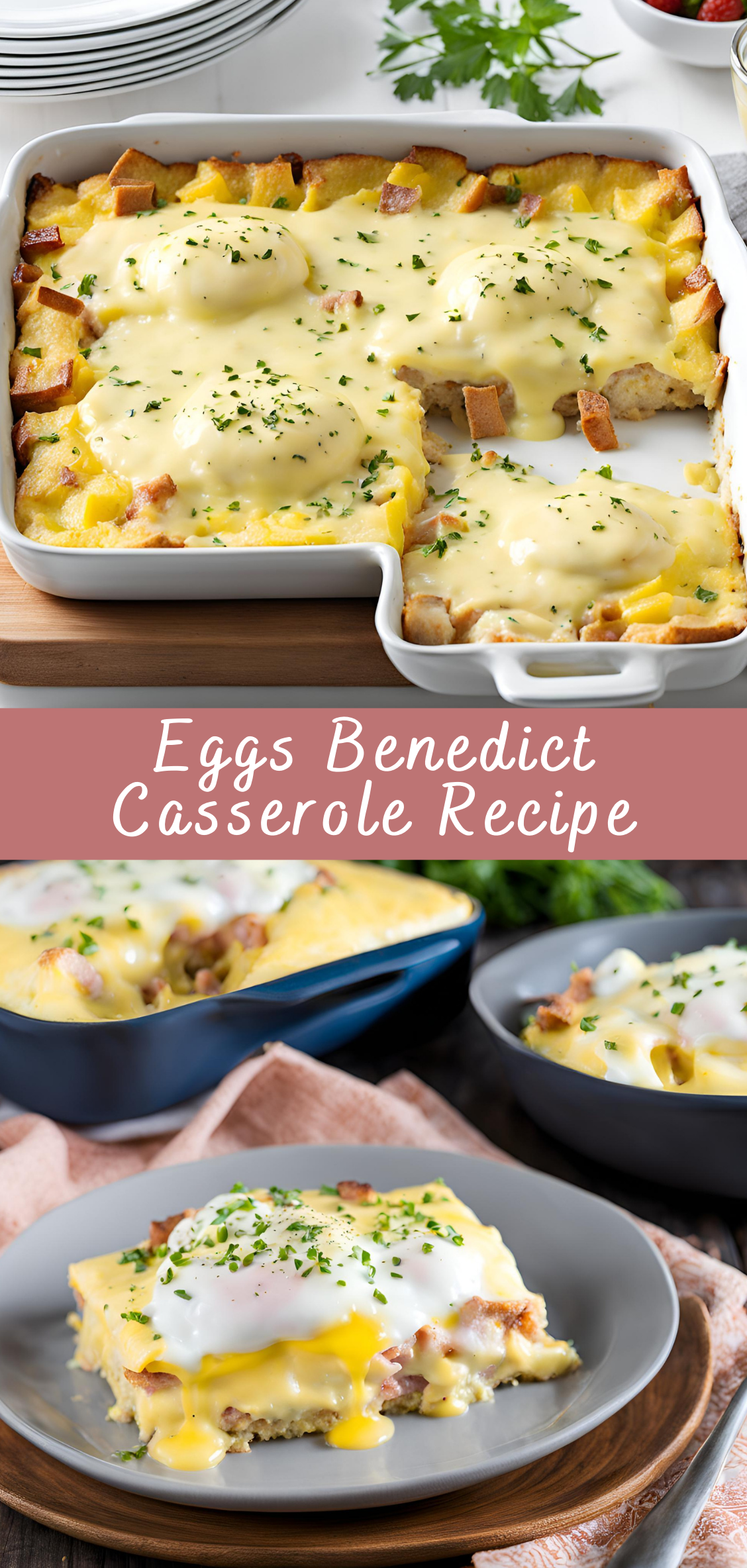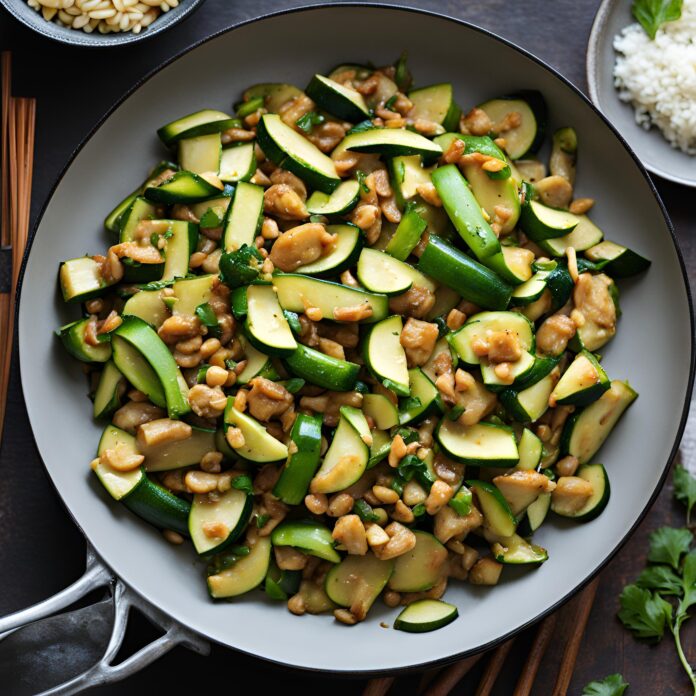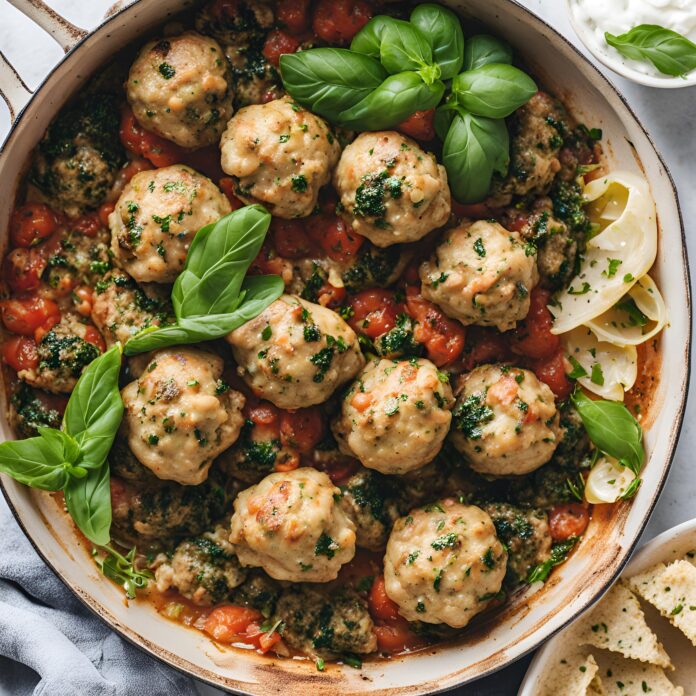Eggs Benedict Casserole Recipe
Eggs Benedict is a beloved brunch dish known for its rich combination of English muffins, Canadian bacon or ham, poached eggs, and hollandaise sauce. The challenge with making this dish traditionally is the time-consuming process of poaching eggs and preparing hollandaise sauce for each individual serving. The Eggs Benedict Casserole is the perfect solution to this problem, as it brings all of the beloved flavors together in a baked casserole form. It’s perfect for serving a crowd at brunch, holidays, or any special occasion.

This recipe simplifies the preparation, allowing you to assemble the casserole the night before and bake it the next morning, making it an excellent option for busy mornings. Plus, the creamy, buttery hollandaise sauce baked over the casserole gives it the perfect touch of decadence.
Preparation Instructions:
1. Prepare the Base:
- Begin by toasting the English muffins. Split the muffins in half and lightly toast them in a toaster or oven until they are golden brown.
- Once toasted, cut each muffin half into quarters, making bite-sized pieces. You can also tear the muffin pieces into irregular chunks if you prefer a more rustic texture.
- Layer the muffin pieces in the bottom of a greased 9×13-inch casserole dish, making sure to cover the entire bottom evenly.
- Add the Canadian bacon or ham: Scatter the pieces of Canadian bacon or ham evenly over the muffin pieces. This will be the savory, protein-packed base that complements the creamy eggs and hollandaise sauce. You can either use thin slices of Canadian bacon or ham or dice it into small pieces.
2. Prepare the Egg Mixture:
- In a large bowl, whisk together the eggs, milk (or cream), Dijon mustard, salt, black pepper, and cayenne pepper (if using). This will create the custard-like base for the casserole.
- Add cheese: Stir in the shredded sharp cheddar cheese (or a mix of cheddar and gruyère) to the egg mixture. This will give the casserole a rich, melty texture.
- Pour the egg mixture evenly over the layered muffin and ham combination in the casserole dish. Press down lightly to ensure the egg mixture soaks into the muffin pieces and coats all the ingredients.
- Cover and refrigerate: If making the casserole ahead of time, cover it tightly with plastic wrap or aluminum foil and refrigerate it for at least 2 hours, or up to overnight. This allows the bread to absorb the custard mixture, which makes for a softer, richer casserole.
3. Bake the Casserole:
- Preheat your oven to 350°F (175°C).
- Bake the casserole uncovered for 45-55 minutes. The casserole should be golden brown on top and set in the middle (a knife inserted should come out clean).
- If the top of the casserole begins to brown too quickly, you can cover it loosely with aluminum foil and continue baking until fully cooked.
4. Prepare the Hollandaise Sauce:
While the casserole is baking, prepare the hollandaise sauce.
- Whisk the egg yolks, lemon juice, and Dijon mustard together in a heatproof bowl. Place the bowl over a pot of simmering water (double boiler method). Make sure the bowl doesn’t touch the water.
- Slowly drizzle in the melted butter while whisking constantly. The sauce should begin to thicken as you whisk. Continue adding the butter slowly and whisking until the sauce is smooth and thick.
- Season the hollandaise sauce with salt to taste and add a pinch of cayenne pepper for some heat (optional). If desired, you can also stir in fresh lemon zest for an added citrusy brightness.
- Once the sauce is ready, remove it from the heat and set it aside. You can keep it warm by placing the bowl over the pot of warm water until ready to serve.
5. Serve the Casserole:
- When the casserole is fully cooked and golden, remove it from the oven and let it cool for about 5 minutes.
- Drizzle the warm hollandaise sauce generously over the casserole, ensuring that each serving gets a rich coating of sauce.
- Garnish with fresh parsley or chives for color and added flavor.
- Serve hot and enjoy!
Tips for Success:
- Make Ahead Instructions:
- This casserole can be assembled the night before and stored in the refrigerator overnight. Simply pop it into the oven the next morning, allowing you to enjoy a hot, fresh breakfast without much effort.
- If you’re making it ahead, ensure the bread has had enough time to soak in the egg mixture. If you don’t have time to refrigerate it overnight, allow it to soak for at least 2 hours in the fridge before baking.
- Baking Tips:
- Be sure to check the casserole’s doneness around the 45-minute mark. If you insert a knife or toothpick into the center and it comes out clean, the casserole is ready.
- If the top is becoming too dark, cover it with aluminum foil and continue baking until it’s fully cooked through.
- Hollandaise Sauce Tips:
- The hollandaise sauce should be made fresh just before serving for the best texture and flavor. If the sauce is too thick, you can thin it with a little warm water, adding a teaspoon at a time until the desired consistency is reached.
- If the sauce separates or curdles, it can sometimes be salvaged by whisking in a tablespoon of warm water, which can help bring it back together.
- Customizing the Recipe:
- Vegetarian Option: You can easily make this casserole vegetarian by omitting the Canadian bacon or ham and replacing it with sautéed spinach, mushrooms, or tomatoes. Alternatively, you can add roasted vegetables like asparagus, bell peppers, or zucchini for a more colorful and hearty dish.
- Cheese Options: While sharp cheddar is a traditional choice, you can experiment with different cheeses like gruyère, fontina, or even brie for a creamier texture.
- Spicy Version: Add a bit of heat to the casserole by incorporating jalapeños or hot sauce into the egg mixture or sprinkling red pepper flakes on top of the casserole before baking.
- Serving Suggestions:
- Serve the casserole with a fresh fruit salad or a side of crispy bacon for a complete brunch spread.
- For an added touch of elegance, pair the casserole with a mimosa or bloody mary.
- You can also serve a side of roasted potatoes or hash browns for a more filling meal.
Variations of the Eggs Benedict Casserole
The beauty of the Eggs Benedict Casserole is that it’s highly adaptable. You can tweak the ingredients and make it your own depending on your preferences or what you have on hand. Here are some ideas for variations that could inspire your next batch:
1. Classic Eggs Benedict Casserole with Bacon or Ham
This version sticks closely to the traditional ingredients of Eggs Benedict, using Canadian bacon or ham. The English muffins, eggs, cheese, and hollandaise sauce remain unchanged, making it a perfect option for those who love the classic flavors.
2. Vegetarian Eggs Benedict Casserole
For a meat-free option, replace the Canadian bacon or ham with hearty vegetables. Here are some ideas:
- Spinach and Mushroom: Sauté fresh spinach and sliced mushrooms, then layer them in the casserole along with the English muffins and egg mixture. This adds a rich umami flavor and makes the casserole even more filling.
- Tomatoes and Avocado: Consider adding sliced avocados and tomato for a fresh and creamy alternative. Roasting or grilling the tomatoes beforehand intensifies their flavor and adds a bit of smokiness.
3. Seafood Eggs Benedict Casserole
For a luxurious twist, why not swap out the ham or bacon for seafood? Shrimp, crab, or even smoked salmon make for a delicious variation that adds a unique, savory touch to the casserole.
- Smoked Salmon: Layer smoked salmon in place of the ham for a traditional smoked fish twist on Eggs Benedict.
- Shrimp: Add sautéed shrimp for an elegant, seafood-inspired brunch option. Shrimp’s delicate flavor complements the creamy hollandaise beautifully.
4. Spicy Eggs Benedict Casserole
If you enjoy a little heat, consider incorporating some spicy ingredients:
- Jalapeños: Add finely diced jalapeños to the egg mixture or layer them between the English muffins and ham for a slight spicy kick.
- Sriracha: Drizzle some Sriracha over the casserole before baking, or mix it into the hollandaise sauce for a spicy twist on the traditional sauce.
- Chorizo: Replace the Canadian bacon with crumbled spicy chorizo sausage for a bold, flavorful version.
5. Low-Carb or Keto-Friendly Eggs Benedict Casserole
For those following a low-carb or keto diet, you can still enjoy this casserole by making a few substitutions:
- Replace the English muffins with low-carb bread alternatives, such as almond flour bread or cloud bread.
- Skip the hollandaise sauce or use a version made with heavy cream or cream cheese instead of butter to reduce carbs and calories.
- Add extra protein by using sausage or bacon in place of the Canadian bacon for an even more satisfying meal.
6. Gluten-Free Eggs Benedict Casserole
To make the casserole gluten-free, use gluten-free English muffins. Many stores carry gluten-free versions, and they work just as well in the casserole without affecting the flavor. Additionally, ensure that the hollandaise sauce is gluten-free by checking that the mustard and any other seasonings used don’t contain hidden gluten.
Troubleshooting Tips for a Perfect Eggs Benedict Casserole
Sometimes, even with the best recipes, things don’t turn out exactly as planned. Here are a few common issues you may encounter while making the Eggs Benedict Casserole, along with how to troubleshoot them:
1. Casserole Is Too Dry
- Solution: The casserole may turn out dry if it’s not baked with enough liquid. Make sure you’re using the correct amount of milk or cream in the egg mixture. If the casserole seems dry after baking, try adding a bit more liquid during preparation.
- Additional Tip: If you’ve made it ahead and stored it in the refrigerator, be sure to let it soak long enough. The bread needs time to absorb the egg mixture for a creamy, custardy texture.
2. Casserole Is Too Wet or Runny
- Solution: If your casserole turns out too runny, this could be because the eggs didn’t cook through properly or the bread didn’t absorb enough of the egg mixture. Make sure to bake the casserole for the full recommended time, checking for doneness by inserting a knife or toothpick into the center. If it comes out clean, the casserole is ready.
- Additional Tip: If making the casserole ahead of time, refrigerate it for at least a few hours or overnight to give the bread more time to soak up the egg mixture.
3. Hollandaise Sauce Is Too Thick
- Solution: If your hollandaise sauce is too thick, add a tablespoon or two of warm water to thin it out. Stir gently and recheck the consistency until you reach the desired thickness. The sauce should be smooth and pourable.
- Additional Tip: If the sauce separates, add a bit of warm water and whisk briskly to bring it back together. If necessary, reheat the sauce gently over low heat while whisking constantly.
4. Top of the Casserole Is Too Brown
- Solution: The top of the casserole may brown too quickly, especially if you’re baking it at high heat. If this happens, cover the casserole loosely with aluminum foil and continue baking until the casserole is fully cooked through.
- Additional Tip: If the casserole is golden and bubbly but not yet set in the middle, reduce the oven temperature by 25°F and bake longer.
5. Casserole Doesn’t Set Properly
- Solution: If the casserole doesn’t set and remains runny in the middle, make sure you’ve baked it long enough. The eggs need to cook fully, so give it time. If necessary, lower the oven temperature and bake for longer to allow it to set completely.
- Additional Tip: Allow the casserole to rest for 5-10 minutes after removing it from the oven before serving to help it firm up.
Serving the Eggs Benedict Casserole for Different Occasions
This casserole is incredibly versatile and can be served in various settings, from casual brunches to elegant holiday meals. Below are some ideas for serving it at different occasions:
1. Holiday Brunch
- The Eggs Benedict Casserole is an excellent choice for Easter brunch, Mother’s Day, Christmas, or Thanksgiving breakfast. It’s easy to prepare ahead of time and serve a large group of people. Pair it with a fresh fruit salad, mimosas, or a bloody mary for a festive touch.
- Tip: You can make this casserole the night before and bake it fresh in the morning, leaving you with more time to enjoy your holiday celebration.
2. Weekend Brunch
- A weekend brunch is the perfect opportunity to serve this casserole, especially if you’re hosting a group of friends or family. It’s an easy way to feed a crowd while still impressing with the luxurious flavors.
- Tip: Serve with crispy hash browns or roasted potatoes on the side to balance the richness of the casserole.
3. Special Occasions or Gatherings
- Whether you’re hosting a birthday brunch, a bridal shower, or a celebratory gathering, this casserole will add a touch of indulgence. You can even make mini versions by baking it in smaller casserole dishes for individual servings.
- Tip: For a more elegant presentation, garnish the casserole with finely chopped fresh herbs like parsley, chives, or tarragon just before serving.
4. Casual Weeknight Dinner
- While Eggs Benedict is traditionally a breakfast dish, it can also be a great option for a more casual dinner, especially if you have leftover ham or bacon. Pair it with a simple green salad or roasted vegetables for a balanced meal.
- Tip: If you’re serving it for dinner, consider adding a side of roasted vegetables or a crisp side salad with a light vinaigrette.
Dietary Modifications and Alternatives
As with any recipe, dietary preferences or restrictions can be accommodated with a few simple substitutions:
1. Gluten-Free Version
- Use gluten-free English muffins or bread in place of regular muffins.
- Double-check the ingredients in the hollandaise sauce and ensure all seasonings are gluten-free.
2. Low-Carb/Keto
- Replace the English muffins with low-carb bread alternatives (e.g., cloud bread or almond flour bread).
- Skip the hollandaise sauce or make a keto-friendly version using heavy cream and reduced butter.
3. Dairy-Free
- For a dairy-free option, replace the cheese and hollandaise sauce with plant-based alternatives. You can use a dairy-free cheese and make a vegan hollandaise sauce using plant-based butter and almond milk or coconut cream.
4. Vegetarian/Vegan
- Omit the meat and use plant-based sausage, mushrooms, or spinach as a substitute. Use plant-based cheese or nutritional yeast for a cheesy flavor in the casserole. Vegan hollandaise can also be made with plant-based ingredients, including tofu or cashews.
Final Thoughts
The Eggs Benedict Casserole offers all the delicious flavors of traditional Eggs Benedict in a more convenient, make-ahead format. With a rich, custardy base, savory layers of ham, and a decadent hollandaise sauce, this casserole is perfect for holidays, brunches, or any occasion where you want to serve something special with minimal effort.
Feel free to experiment with different cheese blends, vegetables, or even meat substitutes to create your own signature version of this dish. Whether you’re cooking for a crowd or just your family, this casserole will surely become a brunch favorite.
The Eggs Benedict Casserole is a fantastic brunch dish that can be tailored to meet your personal tastes, dietary preferences, and the occasion. Whether you’re preparing it for a holiday meal, casual weekend brunch, or an elegant celebration, this casserole is sure to be a crowd-pleaser. It offers all the flavors of classic Eggs Benedict in a convenient and easy-to-serve form. With the ability to customize the ingredients and make it ahead of time, this casserole will become your go-to recipe for gatherings of all kinds. Enjoy experimenting with different variations, and remember to garnish with fresh herbs and serve with a side of love!
Eggs Benedict Casserole Recipe

Eggs Benedict is a beloved brunch dish known for its rich combination of English muffins, Canadian bacon or ham, poached eggs, and hollandaise sauce. The challenge with making this dish traditionally is the time-consuming process of poaching eggs and preparing hollandaise sauce for each individual serving. The Eggs Benedict Casserole is the perfect solution to this problem, as it brings all of the beloved flavors together in a baked casserole form. It’s perfect for serving a crowd at brunch, holidays, or any special occasion.
Ingredients
- 1 loaf of French bread or brioche, cut into cubes (about 6 cups)
- 12 large eggs
- 2 cups half-and-half (or whole milk)
- 1 teaspoon Dijon mustard
- 1/2 teaspoon salt
- 1/4 teaspoon black pepper
- 1/4 teaspoon garlic powder (optional)
- 1/4 teaspoon onion powder (optional)
- 8 oz Canadian bacon or ham, sliced or chopped
- 1 cup shredded cheddar cheese (optional)
- 1 tablespoon fresh parsley, chopped (optional, for garnish)
- For the Hollandaise Sauce:
- 1/2 cup unsalted butter
- 3 large egg yolks
- 1 tablespoon lemon juice
- 1/2 teaspoon Dijon mustard
- Pinch of cayenne pepper (optional)
- Salt, to taste
Instructions
- Prepare the Casserole: Preheat the oven to 350°F (175°C). Grease a 9x13-inch baking dish with butter or cooking spray. Arrange the bread cubes evenly in the dish. Scatter the Canadian bacon or ham over the top of the bread cubes.
- Make the Egg Mixture: In a large bowl, whisk together the eggs, half-and-half, Dijon mustard, salt, pepper, garlic powder, and onion powder until well combined. Pour the egg mixture evenly over the bread and bacon, making sure the bread is fully soaked. Press down gently to ensure the bread is covered. Let the casserole sit for 10-15 minutes so the bread absorbs the egg mixture.
- Bake the Casserole: Cover the casserole with aluminum foil and bake for 30 minutes. After 30 minutes, remove the foil and bake for an additional 10-15 minutes, or until the casserole is golden brown and cooked through.
- Make the Hollandaise Sauce: While the casserole bakes, prepare the hollandaise sauce. In a small saucepan, melt the butter over low heat. In a medium heatproof bowl, whisk together the egg yolks, lemon juice, Dijon mustard, and cayenne pepper (if using). Gradually pour the melted butter into the egg yolk mixture while whisking constantly to create a smooth sauce. Season with salt to taste. Keep the sauce warm until ready to serve.
- Serve: Once the casserole is baked and golden, remove it from the oven and let it cool slightly before serving. Drizzle with hollandaise sauce and garnish with chopped parsley.
Notes
- Make-Ahead Option:
The casserole can be assembled the night before and refrigerated overnight. This allows the bread to soak in the egg mixture, making it more flavorful and custardy. Bake it in the morning for a hassle-free brunch or breakfast.
If you're in a rush, you can refrigerate it for at least 2 hours before baking, but overnight is ideal. - Cheese Variations:
While sharp cheddar is a popular choice, you can substitute or combine it with Gruyère, Swiss, or Fontina for a different flavor profile. Gruyère, for example, adds a nutty and creamy flavor, making the casserole even more decadent. - Gluten-Free Option:
For a gluten-free version, use gluten-free English muffins or bread. Ensure all sauces and ingredients are gluten-free. There are several excellent gluten-free bread options available in stores today. - Vegetarian or Vegan Adaptations:
To make it vegetarian, simply omit the ham or Canadian bacon and replace it with sautéed spinach, mushrooms, or other vegetables of choice.
For a vegan version, swap the eggs for a tofu-based custard and use plant-based cheese. You can make a vegan hollandaise using cashews or tofu, or skip the hollandaise and use a creamy vegan sauce. - Hollandaise Sauce Preparation:
Make it fresh: While the casserole is baking, prepare the hollandaise sauce to serve warm. It can be kept over a double boiler or in a warm spot. If it separates, whisk in a tablespoon of warm water to bring it back together.
Make extra sauce: If you love extra sauce, double the hollandaise recipe to ensure there’s enough for everyone. Hollandaise is rich and creamy, and extra sauce can be drizzled on each individual serving. - Serving Suggestions:
Pair with fresh fruit: A fruit salad or fresh fruit platter provides a light and refreshing contrast to the richness of the casserole.
Sides: Serve with crispy bacon, roasted potatoes, or a simple green salad to round out the meal.
Beverages: This casserole pairs wonderfully with a bloody mary, mimosas, or even freshly brewed coffee or tea. - Crispy Top:
For an extra crispy top, consider broiling the casserole for the last 2-3 minutes of baking. Just be sure to watch it closely to avoid burning! - Hollandaise Substitute:
If making hollandaise sauce feels too challenging, you can use a store-bought hollandaise sauce or make a simpler version by using a mixture of mayonnaise and mustard as a quick substitute. However, the homemade hollandaise sauce definitely adds that rich, buttery flavor and elevates the dish.



